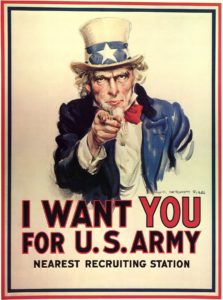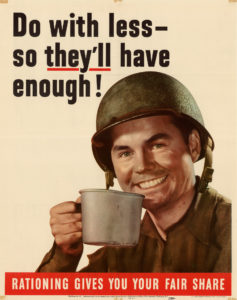 From the beaches of Normandy to the living rooms in the United States, no one was left unaffected by the long and bloody Second World War. Thousands enlisted in the army while others contributed to the war effort from home with the sweat of their labor. As bloody casualties, bombarded cities and weary men grew in number across Europe, the United States government knew that in order to defeat this adversary, the sheer might of military would not be enough – they needed to rally public support and redirect public attention towards the urgency of the impending threat.
From the beaches of Normandy to the living rooms in the United States, no one was left unaffected by the long and bloody Second World War. Thousands enlisted in the army while others contributed to the war effort from home with the sweat of their labor. As bloody casualties, bombarded cities and weary men grew in number across Europe, the United States government knew that in order to defeat this adversary, the sheer might of military would not be enough – they needed to rally public support and redirect public attention towards the urgency of the impending threat.
Thus began an era of coordinated information propaganda to mobilize public support, especially through the creation and spread of war posters. The US government leveraged the power of mass advertisement and commissioned artists to combine visually striking art with powerful words in an effort to connect, inspire and boost morale as well as influence public opinion in support of the war.
This propaganda was spearheaded by the Office of War Information. Established in June of 1942, the department was responsible for managing the art and content of war messages conveyed through posters. They carefully reviewed each design and approved every word to appear on the propaganda posters, and planned each poster’s distribution. Since posters were relatively cheap to produce, it did not take long for them to show up everywhere. The OWI spared no expense in distributing them far and wide for maximum exposure.
 The primary reason behind such aggressive marketing was to rally public support and make each viewer feel like a combatant, with responsibilities equal to that of the young men fighting overseas. The deliberately crafted messages urged the public to conserve their resources, increase output, and reduce waste of time and important minerals. Furthermore, the posters served as an essential instrument in convincing the public of the importance and necessity of conserving and rationing certain minerals such as gas, nylon, rubber, and food items.
The primary reason behind such aggressive marketing was to rally public support and make each viewer feel like a combatant, with responsibilities equal to that of the young men fighting overseas. The deliberately crafted messages urged the public to conserve their resources, increase output, and reduce waste of time and important minerals. Furthermore, the posters served as an essential instrument in convincing the public of the importance and necessity of conserving and rationing certain minerals such as gas, nylon, rubber, and food items.
Meanwhile, soldiers on the ground were given constant reminders of their heroism in participating in the war. Back home, our government reminded the public that no sacrifice is too great. The aim was to transform the American economy into an all-out war production machine, which they ultimately managed to achieve through careful propaganda. Factories that directly supplied essential war materials took it upon themselves to utilize this new medium of propaganda. They designed and distributed their very own posters across factories, directing employees to work harder and to contribute more to the war effort.
However, the intent of these propaganda posters was not to bring about positive change, rather they encouraged a mindset that was needed if we ever hoped to win the war. Hence, the posters served to create a positive atmosphere that encouraged unity among companies and labor forces, which established them as the industrial front line of the war effort.
One of the most striking examples of a shift in public sentiment brought about by a single poster was “The Kid in the Upper 4.” This poster was part of a campaign designed and launched by the New Haven Railroad company to educate disgruntled train passengers on why they were forced to give up their beds to military personnel. The campaign resonated deeply with travelers as well as the overall American public.
Thanks, it is very informative